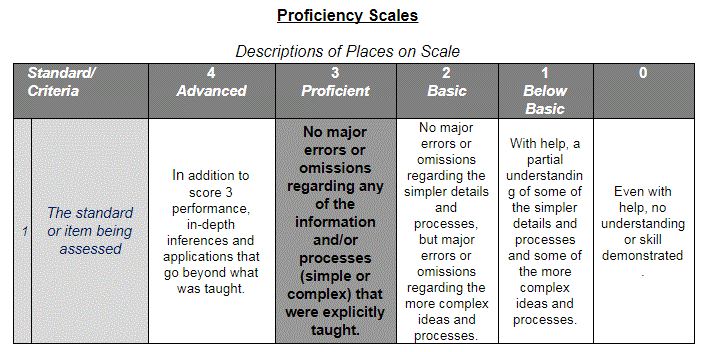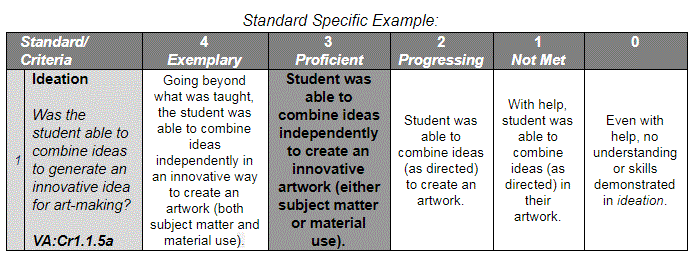Important steps In Designing UnitsStep 1: Determine & Unpack Standards
Step 2: Group Standards into Units Step 3: Identify Enduring Understandings tied to standards Step 4: Decide Themes to frame the unit Step 5: Design Essential Questions within the Unit Theme Step 6: Create Unit Performance Assessment to Assess Priority Standards - Performance Based Assessment & Authentic Art Assessments - Rubrics & Scoring Guides Step 7: Write Lessons that Build Skills to the Assessment |
When to use Rubrics, Scoring Guides, or Proficiency Scales...and what is the difference?
Rubricsfrom The Glossary of Education Reform and Wikipedia...
A rubric is typically an evaluation tool or set of guidelines used to promote the consistent application of learning expectations, learning objectives, or learning standards in the classroom, or to measure their attainment against a consistent set of criteria. In instructional settings, rubrics clearly define academic expectations for students and help to ensure consistency in the evaluation of academic work from student to student, assignment to assignment, or course to course. Rubrics are also used as scoring instruments to determine grades or the degree to which learning standards have been demonstrated or attained by students. A scoring rubric can also provide a basis for self-evaluation, reflection, and peer review. It is aimed at accurate and fair assessment, fostering understanding, and indicating a way to proceed with subsequent learning/teaching. This integration of performance and feedback is called ongoing assessment or formative assessment. Several common features of scoring rubrics can be distinguished, according to Bernie Dodge and Nancy Pickett:
When talking about rubrics, you will most often hear them described as holistic, analytic, or single-point. If you want to dig in and learn more about the differences of those, please check out either of these two resources:
|
Sometimes people use the term rubric—incorrectly—to mean any list-like evaluation tool, and therefore checklists and rating scales are sometimes confused with rubrics. The most important difference between checklists and rating scales on the one hand and rubrics on the other is that checklists and rating scales lack descriptions of performance quality. As we have seen, rubrics are defined by two characteristics: criteria for students' work and descriptions of performance levels. Because checklists and rating scales lack one of these two pieces, they are not rubrics."
Chapter 7
How to Create and Use Rubrics for Formative Assessment and Grading by Susan M. Brookhart
Scoring Guides
The term scoring guide is just another way to say rubric. But I think it implies it is used to help score student work. Therefore, it should provide more details in order to help teachers align scoring to each other, and to help students understand how to earn a certain score, or more importantly, what it means to master a specific standard or skill.
Proficiency Scales
Another tool that is sometimes used to assess student work is a proficiency scale, something I first came across in Robert J. Marzano's book Classroom Assessment & Grading That Work. As defined by Marzano (2006), a proficiency scale represents a progression of learning goals with three levels of difficulty: (1) the target (level 3.0) content; (2) the simpler (level 2.0) content; and (3) the more complex (level 4.0) content. The organization of scales, in addition to representing learning progressions, can also inform how teachers structure classroom lessons and design assessments for each unit or topic addressed
References:
- Brookhart, S. M. (2013). How to create and use rubrics for formative assessment and grading. Alexandria, Virginia USA: Association for Supervision and Curriculum
Development.
- Heflebower, T., Hoegh, J. K., & Warrick, P. (2014). A School Leader's Guide to Standards-Based Grading. Bloomington, IN: Marzano Research.
- Marzano, R. J. (2006). Classroom Assessment and Grading that Work. Alexandria, VA: Association for Supervision and Curriculum Development.
- Brookhart, S. M. (2013). How to create and use rubrics for formative assessment and grading. Alexandria, Virginia USA: Association for Supervision and Curriculum
Development.
- Heflebower, T., Hoegh, J. K., & Warrick, P. (2014). A School Leader's Guide to Standards-Based Grading. Bloomington, IN: Marzano Research.
- Marzano, R. J. (2006). Classroom Assessment and Grading that Work. Alexandria, VA: Association for Supervision and Curriculum Development.


